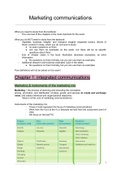Summary
Summary marketing communications
- Course
- Institution
- Book
STILL ACCURATE for the current academic year Clear and structured summary of the course Marketing communications. All information from classes, extra information from the book and guest lectures are included (also the selfstudy parts) No extra material needed when you study this summary. Goodl...
[Show more]




